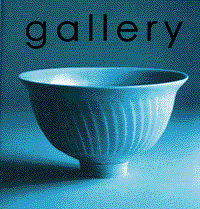| ART 192 - EARTHENWARE UNDERGLAZING |
| UNDERGLAZES are ceramic colors applied, usually on greenware or bisque, and covered with a transparent or semi-transparent glaze. This technique is primarily associated with low temperature glazing. The advantage of underglazing as opposed to overglazing (such as lusters, china paints, or decals) is permanence. The underglaze color is as permanent as the covering glaze. Underglaze colors are modified metallic oxides which usually contain a small amount of glaze, referred to as flux, which binds them to the clay body and integrates then with the glaze above. DUNCAN underglazes are available at the College Bookstore and are quite reliable, however there are many other excellent brands available, and some potters make their own. Colors should be diluted with water to the desired thinness. Usually however, they are mixed thicker than washes - more the consistency of slips. Colors may be mixed successfully with other colors to achieve blended secondary and tertiary colors. I strongly recommend blending colors and using white and black to create tints and shades of existing colors. Some of the least successful pieces result from using the colors pure and undiluted. It is just as if you were to buy oils or acrylic paints and did not mix or blend them when painting on canvas. I recommend painting directly onto clean, dry bisque ware rather than greenware. The piece is stronger, less likely to break, and can be washed off if you don't like what you are getting. Some potters, however, paint directly onto greenware instead. |
| The CC colors made by Duncan are for opaque coverage and should be applied in 2-3 coats for good, non-streaked coverage. The EZ colors made by Duncan are for highlighting, outlining, and are translucent. They should be applied in one, medium-thick application, generally over a base coat of a CC color, or directly on the bisque. You may brush, spray, stipple, sponge, drip, or apply the color in any way you wish. Some testing to gain a touch for how thick an application is best for the effect you want is recommended. Masking tape may be used for stenciling, and wax resist techniques are obviously useable as well. Be creative - any technique that can be done on paper or canvas is achievable on clay with underglaze. Other products now available are underglaze pencils, underglaze watercolors, and underglaze pastel crayons. In the hard slab constructed piece at right, by GCC alumnus David Roesler, underglazes have been applied in a variety of ways, including brushing and inlay. Masking tape was used to block off the diamond shaped areas before brushing on the underglazes. A satin transparent glaze was then applied and the piece fired to cone 05. |
CONFETTI JAR, terra cotta, 16" ht by DAVID ROESLER |
| After painting with underglaze the piece may be coated with a transparent glaze if so desired. If you do not, it will be dry and mat, but this is a nice effect (not so good for food surfaces, however). We use the Duncan transparent glaze specifically made for use with their underglazes, although almost any low temperature clear glaze can be used. Brush on two, flowing coats of the glaze, allowing the piece to dry completely between coats. Fire in an electric kiln (oxidation) to D05. |



